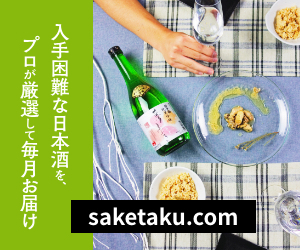- Home
- My Three Meals, My Trip Diary
- Sumida River in Asakusa under a warm spring sky – NIGHT cherry blossoms in full bloom + “Funaguchi Kikusui Ichibanshibori”
Sumida River in Asakusa under a warm spring sky – NIGHT cherry blossoms in full bloom + “Funaguchi Kikusui Ichibanshibori”
- 2020/7/12
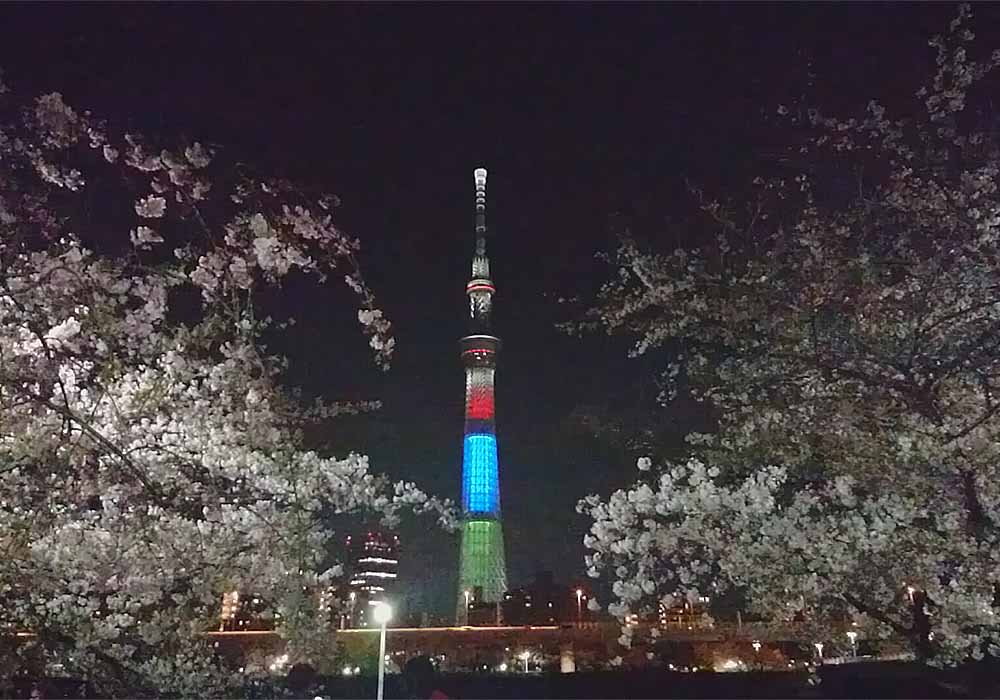
Good evening!
Thank you very much for visiting this blog.
Today’s topic is Hanami (cherry blossom viewing) at Sumida River.
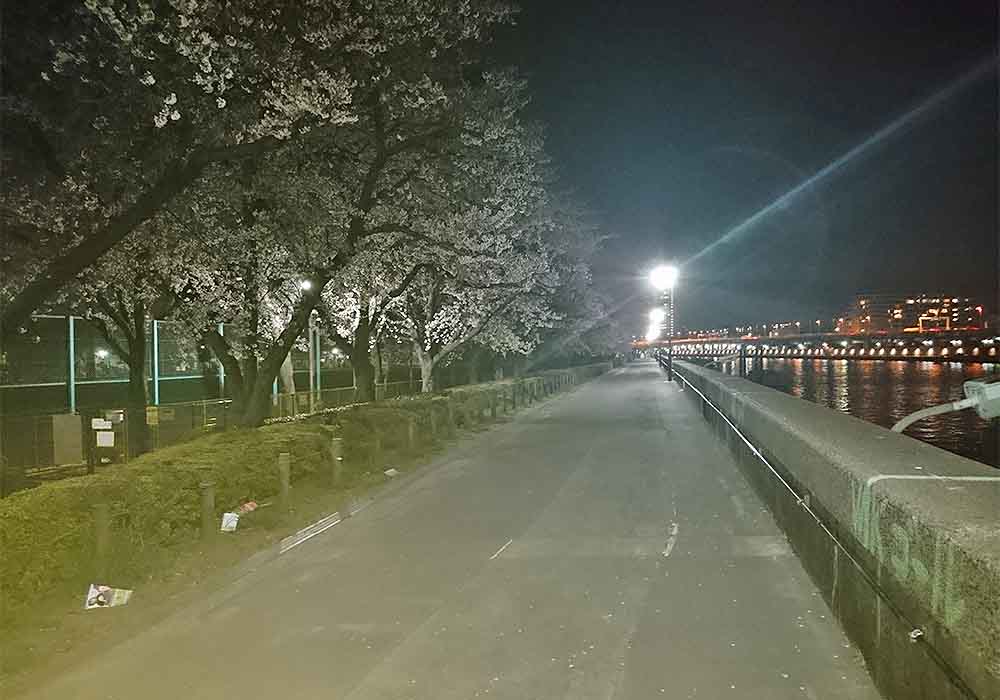
Contents
The right bank of “Haruno Urara” Sumida River at NIGHT
It’s spring.
The weekdays of last week were very cold for April, but it became the normal warm April temperature on the weekend.
The cherry trees along Sumida River in Asakusa started to bloom earlier than usual.
They were almost in full bloom already in the fifth week of March.
I worried about whether the flowers would fall quickly due to the cold weather in April, but the coldness kept the flowers blooming until the first weekend of April instead.
I’d like to appreciate the people who noticed that it’s the same as the last article so far for reading this blog very carefully every time.
I started this article with the same sentences on purpose.
The reason is “contrast”.
The last one was about Sumida River in “daytime”, and I made it very positive and bright for my article.
On the other hand, today’s article is about Sumida River at “night”.
I tried to express in negative way which I’m good at.
This “night story” is actually earlier than the last article’s event in the time order.
When I was having a flower viewing picnic at night, I was drinking by myself.
While I was drinking and thinking about many things alone, I came to an idea to write about the cherry blossoms along Sumida River on this blog.
After that, when I thought about the history of Sumida River and the cherry trees, I somehow thought that I have to introduce the history in the article.
I thought that it would be stronger if I compared “day” and “night” of Sumida River to explain the history.
Therefore, I went to the river in daytime on Sunday to see what the bright Sumida River was like as I mentioned in the last article.
The last article is the introduction of today’s article.
I understand that it’s too much for Sake website, but it’s the unconscious and I can’t help it.
I hope that you’ll enjoy today’s article.
Well, let’s start now.
It was a night on the first Friday of April.
I worked at my client’s place until 9 p.m., and left there for my empty home in Asakusa.
I walked along the bank of Sumida River as usual.
It was the first warm night in a while.
Even though the time was already a little passed 10, there were still many people who were having cherry blossom viewing parties.
I walked slowly enjoying the flowers with a little lonely feeling among the busy parties.
The number of people became less over Kototoi Bridge, but there were more trees there and the flowers were more beautiful.
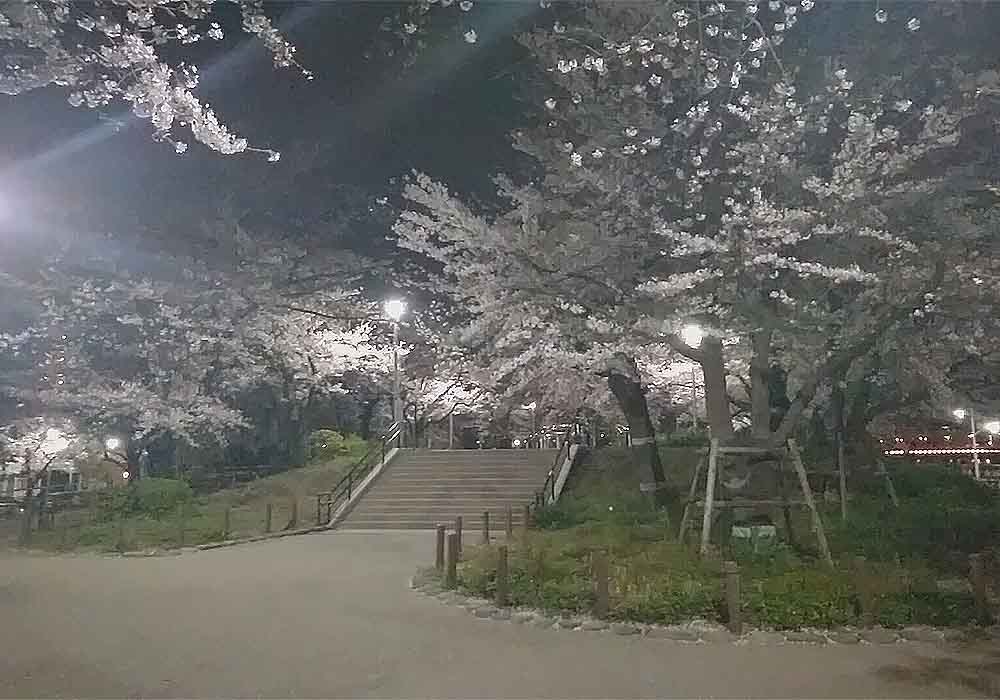
Especially, the cherry trees on the hill were so much beautiful.
When I came to this place, I thought that I could have a cherry blossom viewing picnic by myself comfortably in this place at night.
I couldn’t miss the opportunity to enjoy this seasonal event.
I rushed to my home, changed my clothes, bought a drink & snacks at a convenience store, and went back to the north edge of Kototoi Bridge.
“Funaguchi Kikusui Ichibanshibori” with Asakusa’s “night” cherry blossoms
There were a few groups of parties at the bottom of the hill.
On the hill, there were 4 or 5 people having single flower viewing picnics.
Luckily, there was an empty bench on the hill, so I took it.
As a Japanese saying, “Dumpling rather than flowers (=Bread is better than the songs of birds)”, I took out my sake and snacks.
The things I got were,
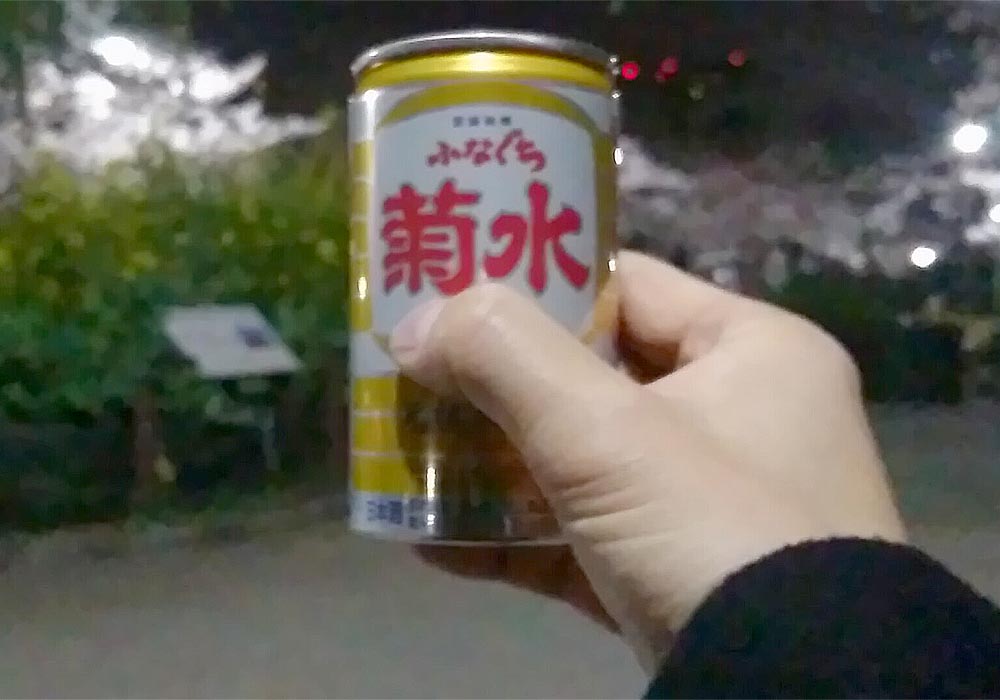
“Funaguchi Kikusui Ichibanshibori”,

“dry sausage” and “Jagariko (Japanese potato snack)”.
From my seat,

I could see cherry trees and Skytree.
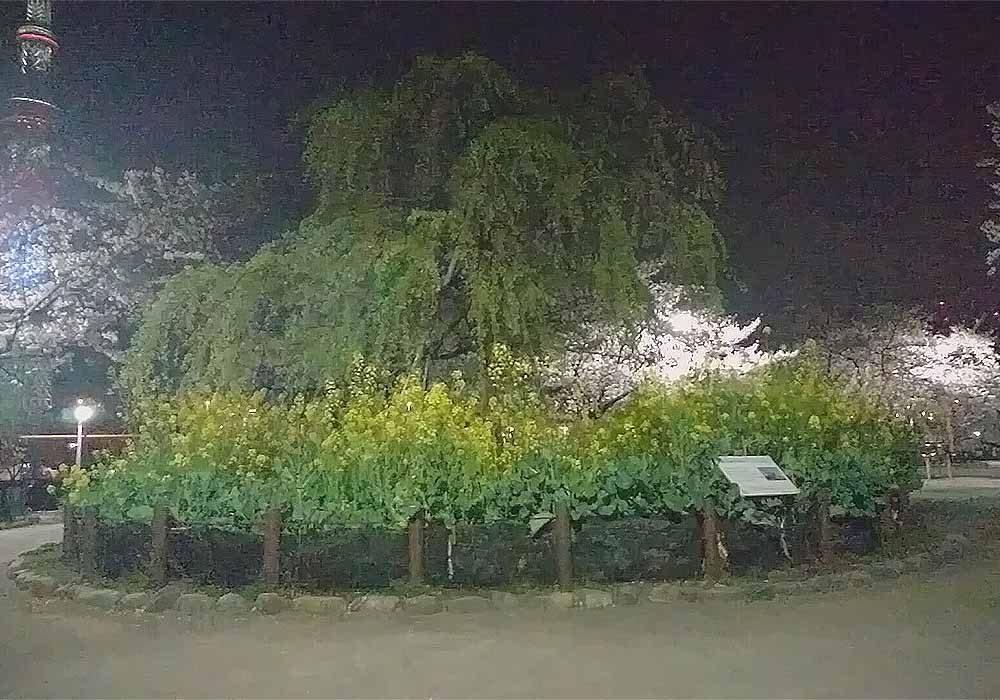
In addition, there were Nanohana (rape blossoms).
It was such a beautiful place.
I raised my sake to the cherry blossoms first, and tried “Funaguchi Kikusui Ichibanshibori”.
I like this sake very much, and I used to choose it for Sunday drinking all the time before.
I can’t drink much compared to before.
I don’t feel good on the next morning, so I now avoid drinking sake when I have to work on the next day.
Therefore, I rarely drink sake recently.
This sake is classified as “Nama Genshu (not heated, no water added in the production process)”, and it’s meant to be had in cold temperature.
However, the convenience store which I bought it at had this sake in the normal temperature.
The sake has stronger alcoholic taste and becomes heavier in the normal temperature.
The taste is dry, but it has deep flavor, too. The after taste was heavy and rich.
I could feel different characteristics compared to the cold one.
The dry sausage had strong pepper and meat tastes.
When I had it with “Kikusui”, the sausage killed the sake’s alcohol and heavy flavor, and the after taste of the sausage disappeared as well.
The other snack, Jagariko. I like cheese flavor.
I should’ve chosen the normal size, not “L” size, considering the calorie.
I tried it with the sake, and found that the snack and the sake killed each other’s taste as well as the dry sausage, even though Jagariko was not so strong.
I imagine that sake is usually designed to go with normal meals, so it’s difficult to go with such light snacks.
The history of Sumida River’s cherry blossoms
I was having “Kikusui” and snacks in turns in front of cherry blossoms and rape flowers both in full bloom.
I enjoyed the situation, and I also thought of many things as I was alone.
For example, I remembered that rape flower was the favorite flower of famous Japanese writer, Ryotaro Shiba.
Another one was that the first cherry trees along Sumida River were planted by the order of Yoshimune Tokugawa.
I also remembered a myth that the reason why cherry blossoms are beautiful is that there are dead bodies under the trees.
This is from a famous phrase in a novel, “Under the Cherry Trees”, by Motojiro Kajii.
When I thought of the phrase, I thought about the history of Sumida River.
The sad history which we can hardly imagine from the present beautiful scenery.
The reason why I decided to write this article, is from my idea that it should be effective to tell the history, and what we need to learn from it by comparing its sadness and the beautiful flowers.
I’d like to start it now. Please skip it if you don’t like sad stories.
The origin of Sumida River’s cherry blossoms
I looked up the history of Sumida River’s cherry trees on the internet, and found that the oldest record about the cherry trees along the river says that the trees were planted between 1624 and 1644.
The famous cherry blossom place was Ueno at that time.
The cherry trees in Ueno were brought from Mt. Yoshino in Nara Prefecture, which was famous for the cherry blossoms since ancient times to improve the view by Tenkai who opened Kan’ei Temple in Ueno.
Ueno’s cherry trees were open for general people to see, but there were regulations, such as no food or drink, no music instrument, and closing at 6 in the evening because Kanei Temple was the Tokugawa’s family temple.
The government might have planted the trees in Asakusa for the people who wanted to party under the flowers because the ones in Ueno were not so popular due to strict rules. (It might be surprising, but the Shoguns in the Edo era were making every effort to get the backing of the public.)
The second oldest record about the cherry trees says that the 4th Tokugawa Shogun and the oldest son of Iemitsu, Ietsuna Tokugawa (1641-1680, in the position 1651-1680), ordered to plant the trees to enjoy the flowers with the people.
As I mentioned in the previous article, Ietsuna is known as a Shogun who ran a good government with the help of Masayuki Hoshina who was the younger brother of Iemitsu.
In his time, there was a rest house for Shogun in the present Shirahige Park on the east bank of Sumida River (it was called “Sumida Gawa Goten”). Shogun used the house when he went to the suburb for hawking and other purposes.
It is thought that the cherry trees which were planted in Ietsuna’s time were planted around this “Sumida Gawa Goten”.
Later, when Ken Matsudaira Yoshimune Tokugawa was the 8th Shogun, trees were planted on the banks of Sumida River by Yoshimune’s order in 1717 and 1726.
Around 1717, a gatekeeper of Chomei Temple where the trees were planted, Shinroku Yamamoto, started to sell sweet rice cakes wrapped with salted cherry leaves.
It’s said to be the origin of the present Sakuramochi.
There is still a shop called “Yamamoto-ya” in front of Chomei Temple now providing Sakuramochi.
(Rice cake wrapped with salted cherry leaves with sweet bean paste inside. “Sakura” means cherry, and “mochi” means rice cake in Japanese.)
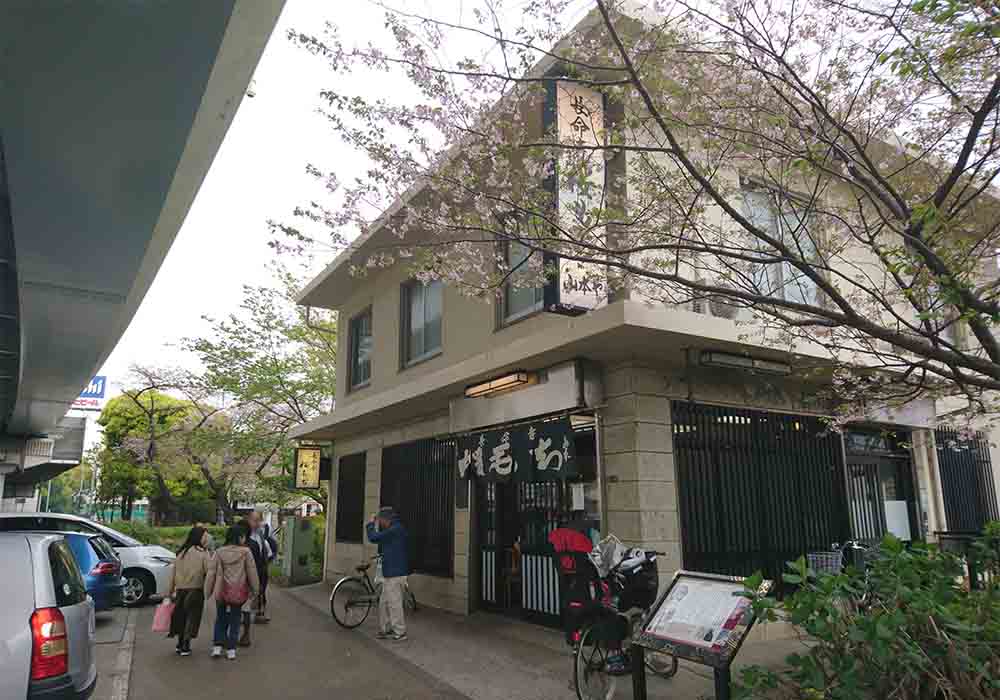
The next photo is the Sakuramochi of “Yamamoto-ya”.

It had a slight cherry scent, and the texture was soft and springy.
It wasn’t too sweet, but just well balanced and delicate.
By the way, I bought this Sakuramochi on the different day from the night picnic.
I bought it on the day of the Waseda vs Keio regatta on Sumida River, and there were shops on the left bank on that day, too.
I found Nihonshu sold at the shops, so I got one and tried it with the Sakuramochi.
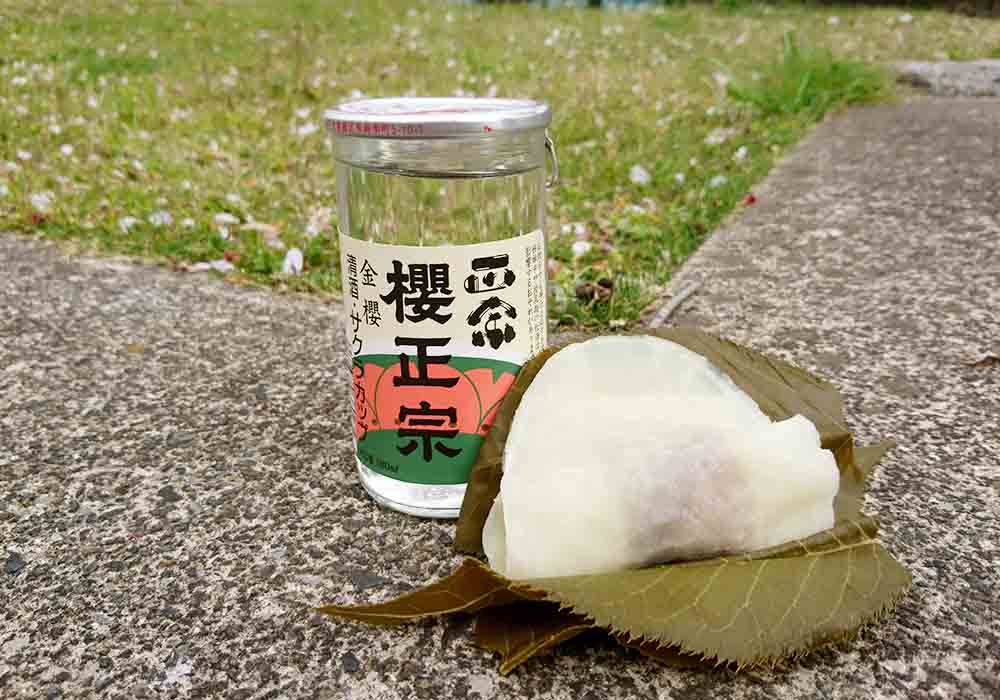
The season of cherry blossoms, Sakuramochi, and the sake’s name was “Sakuramasamune”.
The full-course of “Sakura”!
“Sakuramasamune” was dry and light, and refreshing like water.
The aftertaste was clear, and didn’t have too much characteristics.
When it went with Sakuramochi, the elegant sweetness of bean paste and the dryness of “Sakuramasamune” got mixed together, and they became like some kind of syrup.
The sake is very light body, so I felt that it goes well with sweet foods, too.
Near the shop “Yamamoto-ya”, there is a stone monument called “Bokutei Shokuou no Hi” to tell the history of tree planting along Sumida River.
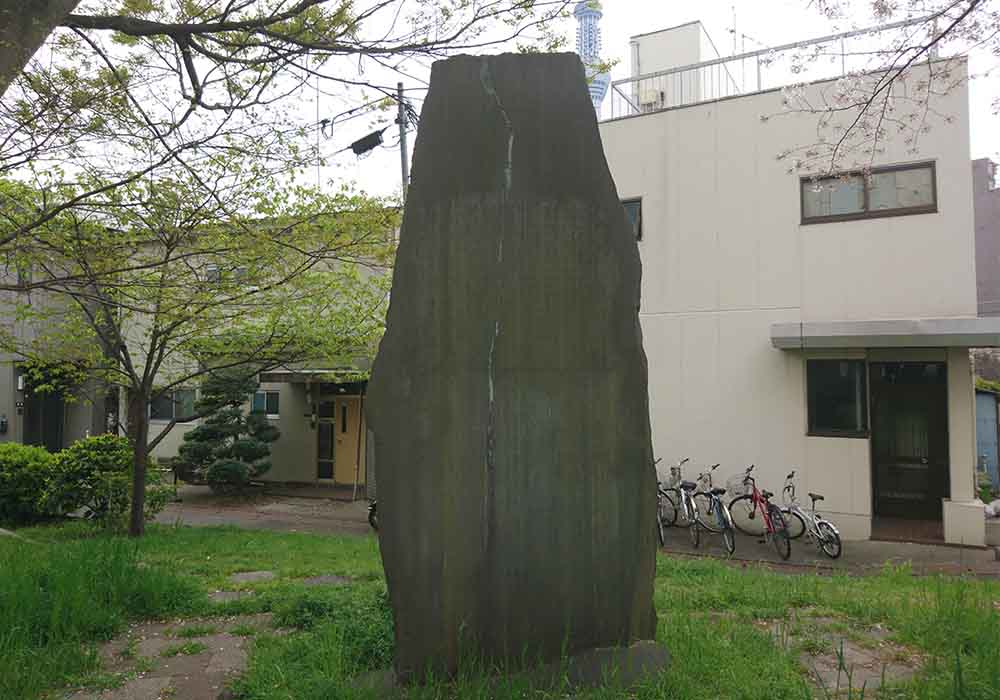
Talking about Yoshimune Tokugawa, he is known as a Shogun who conducted the tight fiscal policy to reconstruct the government’s finance in “Kyoho Reforms”.
As well as the financial restricts, he also ordered to plant cherry trees to entertain the people maybe because he had ability to feel the people’s minds.
(There is another story that he planted trees to tread hard the river banks by the cherry viewing people.)
By the way, the person who started the firework festival of Sumida River in summer was also Yoshimune Tokugawa.
After Yoshimune planted the trees, the local people kept taking care of the trees and increased the number of the trees.
Thanks to the efforts, the cherry blossoms along Sumida River became one of the main sights of Edo, and became so attractive that it was painted in many Ukiyoe arts.
The trees were first planted in the upper stream area around the present Sumidagawa Shrine near Kanegafuchi Station, and they came to the south gradually.
It was around 1880 when the trees came to the opposite bank of Asakusa, the area around Sumida Ward Office and the main office of Asahi Beer.
The place we think is the main place for the cherry blossoms now didn’t have flowers in the Edo period.
National Science Museum: http://www.kahaku.go.jp/userguide/hotnews/theme.php?id=0001217208235425&p=4
Collaborative Reference Database: http://crd.ndl.go.jp/reference/modules/d3ndlcrdentry/index.php?page=ref_view&id=1000013733
Asahi.Net: http://www.asahi-net.or.jp/~zr8t-iskw/bokutei_shokuou.html
Great Kanto Earthquake and the reconstruction project along Sumida River
Sumida River became famous for the beautiful cherry blossoms in a long history.
In the history, there was a big turning point on the first day of September in 1923.
It was the day of Great Kanto Earthquake.
The earthquake came in the lunch time, so the fire for cooking made a big fire on the houses.
In addition, a typhoon was approaching near Noto Peninsula, so there was a strong wind in Kanto area.
Therefore, it became a huge fire in the both sides of Sumida River, Asakusa, and Honjo area.
Even a firestorm (pillar of flame) appeared.
Many people ran into the river to escape from the fire.
However, much fire sparks fell on the people from the sky, and many people got burned to death on the riversides and even in the water.
There are stories of people who survived the earthquake that the water of the river was like boiling water as many burning iron boards or wooden electric poles fell into the water.
The fire from the earthquake destroyed Asakusa and Honjo completely.
I couldn’t find records to tell what happened to the cherry trees, but I imagine that they were lost.
After the earthquake, Japanese government placed Shinpei Goto as the president of new Imperial Reconstruction Department, and made “Imperial Reconstruction Plan”.
For Sumida River area, the government constructed Sumida Park and Kototoi Bridge.
The government mentioned about the construction of Sumida Park as follows;
“We will develop both banks of Sumida River’s upper stream from Azuma Bridge to Shirahige Bridge, and construct a park through the area.
This is for pleasure uses for the people in peace time, and for a shelter in disasters.
As well as being the biggest river park in Tokyo, it also will play an important role to keep many historical sites which remain in this area.”
To develop the park, cherry trees were planted in this area again.
This reconstruction made the present Sumida Park on the both banks, and “Sumida River’s cherry blossoms” which we know now.
The interviews of Great Kanto Earthquake survivors: http://www.hiroi.iii.u-tokyo.ac.jp/index-genzai_no_sigoto-tokyo_chokka_jisin-kantojisin_taiken1.html
The history of Sumida River: http://library.jsce.or.jp/jsce/open/00902/2004/24-0045.pdf
Great Tokyo Air Raids and Sumida River
Sumida River recovered from the earthquake with people’s efforts.
On March 10th in 1945, another disaster occurred.
America conducted carpet bombing all over the Sumida basin by B29.
This attack is called “Great Tokyo Air Raids“.
This attack was done by U.S. forces under the official purpose to lose Japan’s ability to continue the war by destroying factories in cities, and the hidden purpose to lose people’s will to fight by a genocide.
America studied Japan’s landscape, houses, and histories very carefully, and invented effective weapon (incendiary bombs).
They had experiments in advance, and chose the attack day considering the weather.
They also expected a strong seasonal wind to spread the fire efficiently.
The first plane dropped bombs on Fukagawa, Honjo, Asakusa, and Nihonbashi at 00:07 a.m. on March 10th.
The following 279 B29 started to attack from the eastern area which was the lee side to the west.
They dropped incendiary bombs of 381,300 shots and 1,783 tons.
Incendiary bombs explode and ignite incendiary agents inside when they hit the land or buildings, and create many fire balls outside to burn things around.
The smoke of the fire reached 15,000 meters high.
Firestorms like the one in the great earthquake appeared, and the city got covered with fire.
To escape from the fire, people rushed to Sumida River and Arakawa River.
The next photo is Kototoi Bridge which I introduced you in the last article.
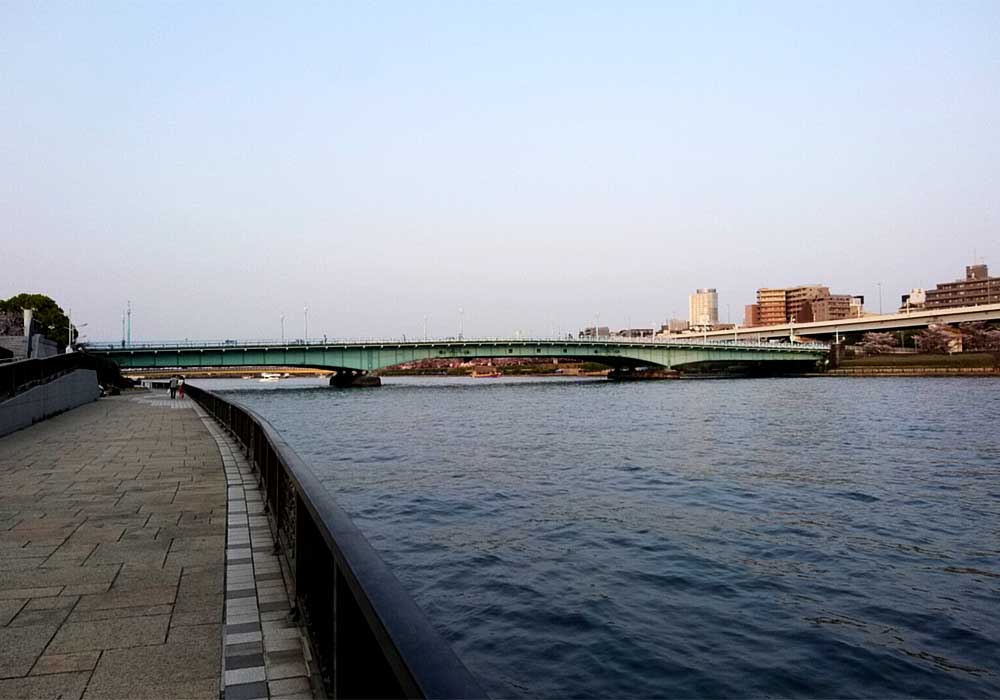
Many people came to this bridge from each side because they thought that they would be able to stay away from the fire if they crossed the bridge.
Therefore, too many people gathered on the bridge, and they couldn’t even move because it was too crowded.
The firestorm reached there, and the fire burnt the people on the bridge.
There were a lot of burned bodies on the bridge after that.
There were also many people who dived into the river.
However, incendiary bombs contained jellylike petrol as the agent, and the surface of the river was covered with fire of the petrol.
It even killed people in the water.
In another case, people froze to death in the cold water of the early March.
Wikipedia – Great Tokyo Air Raids: https://ja.wikipedia.org/wiki/%E6%9D%B1%E4%BA%AC%E5%A4%A7%E7%A9%BA%E8%A5%B2
Wikipedia – Kototoi Bridge: https://ja.wikipedia.org/wiki/%E8%A8%80%E5%95%8F%E6%A9%8B
Memorial stone and cherry trees in Sumida Park
I was having a night flower viewing picnic in Sumida River.
Near the place, on the edge of Kototoi Bridge, a monument stone stands quietly.
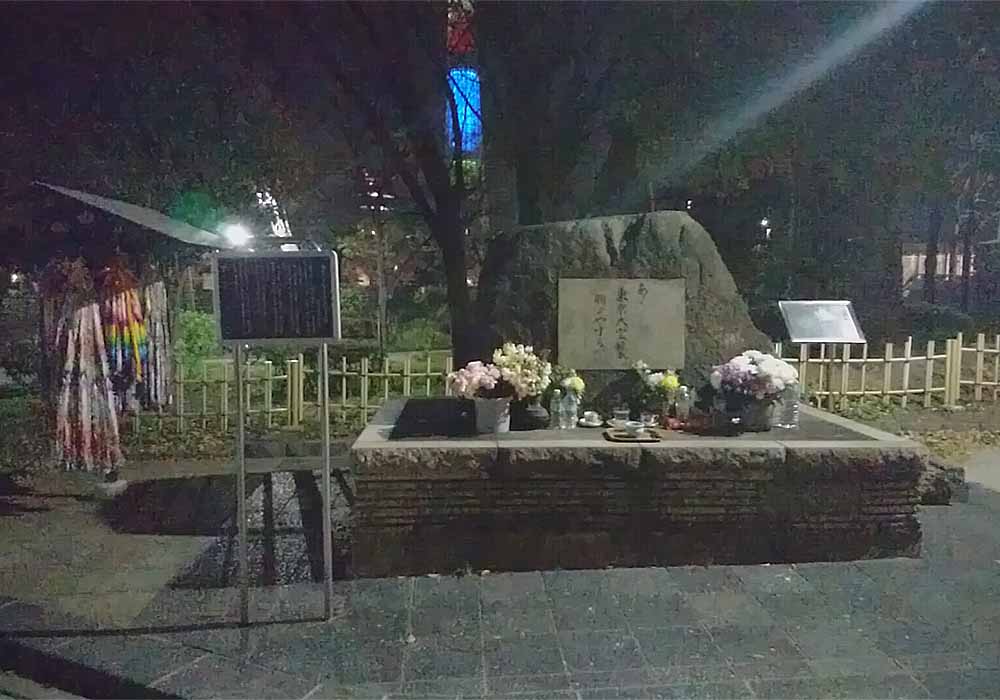
It’s a monument to mourn the victims of Great Tokyo Air Raids.
The explanation board says that the bodies of the victims in the attack on March 10th were gathered in this place to bury temporarily, and they were cremated after the war. Their ashes were laid in Tokyo Memorial Hall in Yokoami-cho, Sumida-ku.
It’s been 74 years since the air raid.
Now many people visit this park and bridge to enjoy cherry blossoms.
When I think about the sad history, I feel sorry, and at the same time, I understand how precious the present peaceful time is.
74 years ago, there were many dead bodies of the people who died in the attack there, and cherry trees were lost.
Now we can see beautiful cherry blossoms, and enjoy sake under the trees peacefully.
I often see many opinions to support Japan’s rearmament and being like other countries on the internet.
I also think that Japan will need to rearm considering China’s expanding power, nuclear weapons in North Korea, and the friction between Japan and South Korea.
However, I am definitely against rearmament without understanding our terrible history.
To study Japan’s history, I feel that Japanese people have a characteristic to go to extremes.
When we took pacifism after the war, we tried to be fanatical pacifist without any armies.
On the other hand, we continued wars under many extreme policies, such as “Hakkou Ichiu (Building the united world)” “Daitoua Kyoueiken (Asian Union)” “Tokkou (Suicide Attack)” or “Ichioku Sou Gyokusai (Continuing war although all Japanese are killed)”, and Japan was trying to continue the war until all the people in the country die.
I understand that the “peer pressure” in Japan’s society is making it difficult to correct the politics to avoid destruction unless we have a powerful leader.
Japan’s economy should be kept good until Tokyo Olympics in 2020.
I worry about what it will be after the economy declines and many negative things which Japan has piled explode.
In any cases, it’s us who choose our future.
Whatever the future will be, it’s our responsibility.
I hope that Japanese people not to make their decisions with temporal emotions.
We need to know our histories like I wrote in this article, and understand that the incidents can happen to us now as well.
If we can do it, everyone should think that we must not make Japan like before the war again.
In the internet media such as yahoo news, I see many comments which denounce criminals and someone who failed something.
Other anonymous comments label someone as a criminal even though he’s still a suspect yet with not enough evidence, and such comments demand capital punishment for the suspect.
I feel that the growing gap between rich and poor is making Japanese people depressed and have evil way of thinking.
If they can imagine that what they are blaming can also happen to themselves, they should have different points of view.
It’s same for the war history.
The tragedies which I wrote earlier might happen to our future.
North Korea’s nuclear missiles might hit Tokyo.
China might attack Tokyo by missiles or bombers for the controversy on Senkaku Islands.
The old war days might start again in our country.
If people can have sense to imagine such things, they should be able to think differently about the problems of North Korea, Senkaku Islands, and the friction with South Korea.
Of course, the number of people who claim extreme opinions is limited.
However, to look back the history, Japan sometimes ran into extreme and unpeaceful direction after such few dangerous opinions.
What I can do might be only little, but today I wrote this article to introduce our history which we must not choose again to avoid a bad future.
The purpose of comparing cherry blossoms in daytime and night was to express Japan’s unconscious mind to demand wars behind the peace.
My expression is too poor to tell it enough, but I still hope that someone read this article and know our sad history, and it will help our future be better.
It's our great pleasure if this article is helpful for you.
Restaurant Information
| Shop Name | |
|---|---|
| Prefectures | - |
| Tel | |
| Address | |
| Nearest Station | |
| Homepage | - |
| Business Hours | - |
| Holiday | |
| Introduction | |
| Sake List |
|

